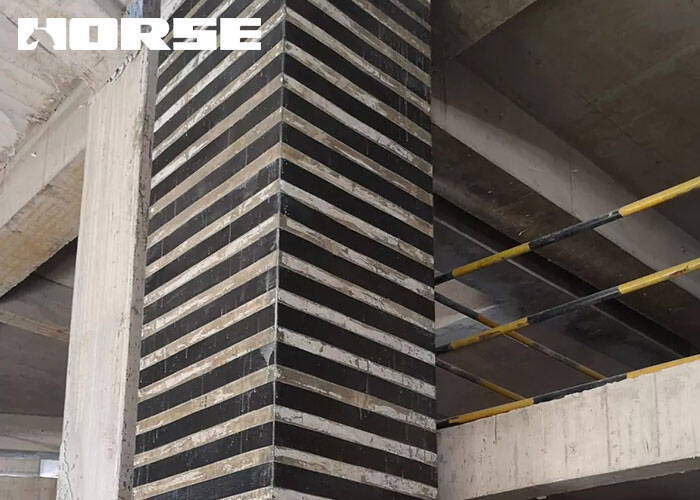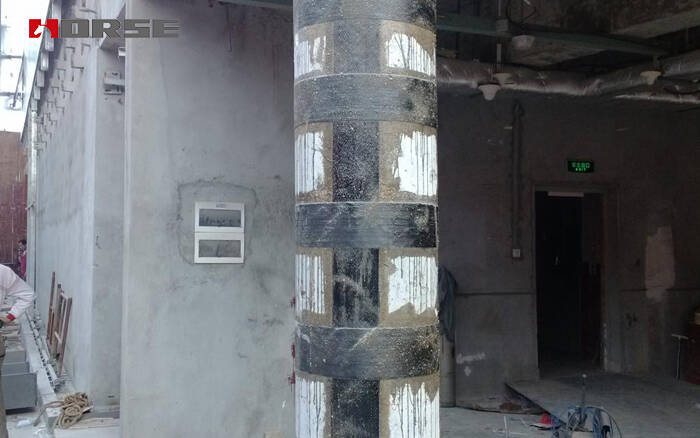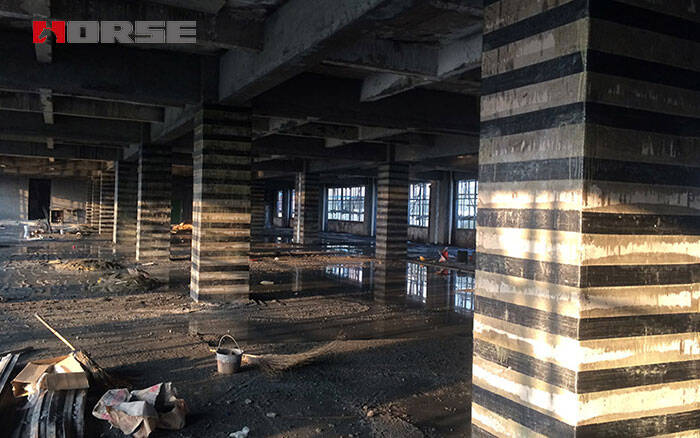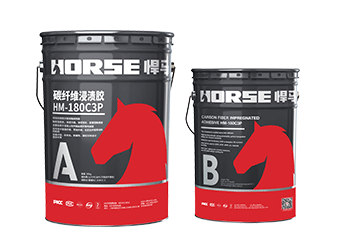Solutions
Horse Construction offers full range of structural strengthening materials with technical supports, documentation supports, products supports, project supports.
Reinforce Concrete Structure With Carbon Fiber Wrap

Concrete can be easily cast into the required shape, so it has been widely used in construction. However, concrete has its own shortcomings, which subsequently affect the strength and quality of the structure. The tensile strength of concrete is very weak. Therefore, under extreme weather conditions, seismic frequencies or additional loads, the concrete will gradually crack and weaken the structure.
The carbon wrapped column system can successfully repair, strengthening and retrofit concrete structures.
Concept
In order to increase the compressive, flexural and shear strength of the structure, carbon fiber reinforced polymer(CFRP) is wrapped with resin on the structure. Although there are many fiber wrapping systems available, carbon fiber wrap is the most preferred system for structural strengthening.
Column carbon-wrapped materials or carbon fiber reinforced concrete are widely used in various building types for building maintenance or concrete structure reinforcement, including: residential structures for industrial chimneys and bridges, industrial structures, and commercial properties.

Apllication
When building floors above stilts or laying additional floors above ground/bungalows, beams and columns must be reinforced to be able to withstand the weight of the new structure. FRP carbon fiber wrapped on the base column is the most mature and effective technology for strengthening concrete structures and building higher floors.
After the slab is cast, if the column fails within 28 days, the carbon fiber wrapping system is used to repair and achieve the required strength.
In places experiencing seismic activity or earthquakes, FRP wrap is a very important renovation of concrete structures and makes them earthquake resistant.
Sometimes, based on demand, people tend to convert residential properties into commercial properties. Now, the load pattern that falls on the structure has been changed, so the structure must be strengthened to maintain the newly increased capacity. Carbon fiber wrapping is also an effective technology.
The most common use of FRP is to strengthen industrial structures affected by heavy loads and mechanical vibrations.
In areas with extreme climatic conditions or high humidity, carbon fiber packaging can enhance structural strength and reduce environmental damage.
Similarly, in the case of structural repair or structural deflection, when beams and columns begin to sag or cut out or repair defective structures in RCC walls, carbon fiber wrap is the most preferred alignment system and reinforcement.

Installation steps
Compared with glass fiber-based systems, carbon has higher quality, tensile strength and durability. There are prefabricated FRPs in the form of rods and plates on the market, which are mainly used for hard or curved surfaces. Continuous rolls are used for packaging.
Process
>>The treatment of concrete surface
The cosmetic layer, oil, dirt etc. Of concrete surface should be chiseled off and then rubbed off 1 ~2 mm thick surface layer with the angle grinder, concrete components should be handled by chamfering on the corner, dust was blew out with compressed air after the completion Of polishing, and finally the surface was wiped by cotton cloth dipped in acetone, and kept dry for use. If the concrete needed to strengthen existed cracks, first choose HM-120M perfusion adhesive or HM-120L pouring crack adhesive to perfuse according to the size of crack, and then strengthen.
>>Primer construction
When construction, two components of HM-180 primer were weighed according to the stipulated proportion of preparing glue, and dumped into a clean container and stirred to uniformity (when mixing, best mix along the same direction to avoid the air from form ingair bubbles.) Brush or roller brush was used to evenly brush on the concrete surface, after the glue surface layer dried, it should be brushed several times depending on the particular circumstances, but the coating thickness did not exceed 0.4 mm, and it should not be missed out to brush, or have flowing or bubbles, waiting for glue curing (curing time was depended on the site temperature, it was appropriate when finger felt dry, generally not less than 2 hours), then the next process was proceeded. The glue prepared every time should be used up one time during the applicable period of the glue.
>>Leveling construction
The pores and defects on concrete surface were filled by HM-180CE leveling adhesive. When depression area was existed, the prepared leveling adhesive was used to repair and fill through scraper embedding and scraping, the position emerging altitude difference such as the joint of templates should be filled by leveling adhesive, which tried to minimize the height difference. The treatment of corner was that it was repaired to smooth arc through leveling adhesive, its radius was not more than 20mm. After the leveling adhesive cured (curing time was depended on the site temperature, it was appropriate when finger felt dry, generally not less than 2 hours), the next process should be proceeded further.
>>Paste of unidirectional carbon fiber sheet
HM-180C3P carbon fiber impregnated adhesive was smeared to the pasted area evenly, the corner site was more smeared appropriately. Paste after hauling unidirectional carbon fiber sheet tight and alignment, use a plastic scraper or roller (a paint roller that the villus was removed outside) to roll repeatedly along the same direction, until the glue compound exuded. And then smear impregnated adhesive to the outside surface of the carbon fiber sheet evenly, and roll repeatedly that the impregnated adhesive can immerse the carbon fiber sheet in two ways, if it is multi-paste, until your fingers touch dry, the next layer of paste can be beginner. If the carbon fiber sheet needs overlapping.
>>Curing and conservation
Prevent rain or moisture 24 hours after the completion of construction, and pay attention to protection against a hard Object bumping into the surface of the construction. When the average air temperature is 20 , 25 ℃ , the curing time is not less than 3 days; when the average air temperature is 10 ℃, the curing time is not less than 7 days.
You can find anything here you are in need of, have a trust trying on these products, you will find the big difference after that.

High strength, unidirectional carbon fiber wrap pre-saturated to form a carbon fiber reinforced polymer (CFRP) wrap used to strengthen structural concrete elements.

Good impregnation carbon fiber adhesive for applying carbon fiber reinforced polymer(CFRP) wrap for structural strengthening

High strength carbon fiber reinforced polymer (CFRP) strip / laminate / plate for structural strengthening and concrete repair